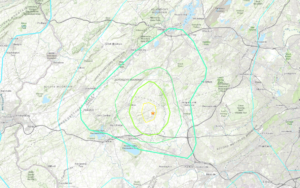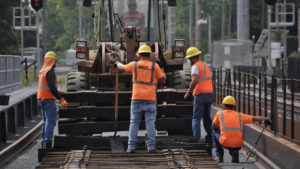Railroad ordered to remove old ties
Written by jroodHundreds - perhaps thousands - of old creosote-soaked railroad ties dumped along a 30-mile stretch of the Deschutes River may be removed in coming months thanks to persistent cage-rattling by Eugene, Ore., businessman and clean-water enthusiast John Brown, The Eugene Register-Guard reports.
Brown, a real estate
broker, avid angler and commissioner with the Eugene Water & Electric
Board, has spent the past five months complaining about the railroad ties to
state officials and local and state politicians. Brown’s complaints bore fruit
on March 1, when the state Department of Environmental Quality ordered the
railroad owner, BNSF, to remove the ties. While steelhead fishing on the lower
Deschutes last November, Brown had noticed the railroad ties on the west bank
of the Central Oregon river.
BNSF, one of the nation’s
biggest railroads with 32,000 miles of track, owns the line that hugs the river
through the spectacular Deschutes Canyon, a place that attracts thousands of
anglers and boating enthusiasts each year. Brown regularly fishes the Deschutes
River, but it had been years since he had been on that particular stretch, a
30-mile run from the tiny town of Maupin down to South Junction.
"It’s an incredible
free-flowing glacial-fed river full of salmon, steelhead and wonderful native
trout," and the last place you’d want to see junked railroad ties, Brown said.
Railroad ties are a
crucial part of a railroad’s structure, holding the rail lines in place. They’re
also highly toxic. The heavy wooden timbers are pressure-soaked in
creosote to protect them from insects and weathering. A derivative of coal tar,
creosote contains hundreds of different chemicals, many of them polycyclic
aromatic hydrocarbons. Some PAHs are toxic to aquatic organisms and designated
as hazardous pollutants, said Suzana Radivojevic, a consultant with the
Eugene-based Oregon Toxics Alliance. The chemicals can leach out of the wood
for years and into the water and can accumulate in sediments and plants,
Radivojevic said. The leaching depends on many factors, such as the age of the
wood, temperature and water flow rates, she said.
"Just the fact that there
is an incredible number of waste ties which are potentially harmful to the
environment does justify public concerns and calls for their removal from the
river," she said.
State and federal rules
regulate the disposal of wood preserved with creosote. In general, railroads
can store waste ties along their tracks temporarily, but not for longer than
six months.
Railroads typically
replace old ties as they decay. Brown said it’s clear that BNSF cut up the old
ties and pitched them down the riverbank during the company’s ongoing repair
and maintenance of the track.
"It just absolutely
aggravates me to no end," Brown said. It’s "obvious that they cut them in half
and threw them down the banks. … What they did was wrong in my opinion."
So he hired a guide to
revisit that stretch of the river and photograph the ties, noting their exact
location with GPS coordinates. Brown then sent the photos and other information
to the DEQ and asked for an investigation. The result: DEQ’s warning letter to BNSF.
The letter informs the railroad that the ties along the Deschutes are a Class
II violation of state regulations, which restrict wastes that are placed where
they can be carried into state waters by any means. The letter notes that some
ties already are in the water and calls for the railroad to develop a plan, due
April 2, for their removal. The plan must address how the railroad will dispose
of the ties that are either in the water or lying along the banks between the
railroad and the river, and the time it will take to get the job done. The
state also wants to know how BNSF currently disposes of its ties.
Brown said that while he’s
pleased with the warning, he wishes the state had fined BNSF. "Where is their
disincentive not to do it again?" he said.
Fines could be in the
railroad’s future if it doesn’t do the cleanup, said Susan Christensen, a DEQ
solid waste technical assistant. "We’re willing to work with them to figure out
what the best plan is to get the material out and how to prevent this in the
future," she said.
The state requires that
railroad ties be disposed of at a landfill that has a permit for such
materials.
A spokesman for the
railroad said company engineers are reviewing the letter and planning a
response.
"We’re developing a plan,"
said Gus Melonas, a railroad spokesman in the Seattle office. "We take
environmental issues seriously and we plan to respond."
Melonas said he didn’t
yet know how extensive the problem was or how much it would cost to comply.
Brown speculated that it
wouldn’t be cheap or easy.
How long the ties have
been there isn’t clear. Back in 1992, Bend resident Fred Boyle made the same
complaint. Boyle, who had just retired as president of Central Oregon Community
College, asked the railroad to clean up thousands of ties along the Deschutes,
ties he said he had been looking at for 25 years as a fly fisherman.
Boyle made a videotape of
the debris along the river, and wrote letters to then-Gov. Barbara Roberts and
other state and federal officials, according to a Jan. 31, 1992, story in the
Bend Bulletin newspaper. He asked that the cleanup be part of a management plan
being written for the river.
Burlington Northern’s
spokesman at the time told the newspaper that the railroad planned to respond
to Boyles’ concerns, but expected it to take several years. Railroad spokesman
Melonas said the ties from 1992 had been cleaned up, but that the railroad’s
regular tie-replacement work means there are still junked ties along the line.





